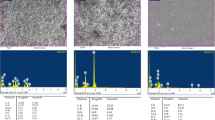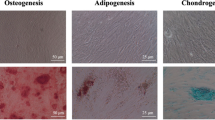Abstract
Objective
Compositional modifications may alter the biological and physicochemical characteristics of calcium silicate-based sealers (CSBS) and, ultimately, their bioactivity. The main objective of this study was to evaluate the biological properties of three CSBS: EndoSequence BC Sealer, Ceraseal, and Endoseal mineral trioxide aggregate.
Materials and methods
Human periodontal ligament stem cells (hPDLSCs) were exposed to several eluates of CSBS. The ion release profile and pH were determined, and metabolic activity and cell migration were assessed using the MTT and wound healing assays. hPDLSCs were cultured in direct contact with the surface of each material, and cell morphology and attachment were analyzed by scanning electron microscopy (SEM). Bioactivity potential was assessed by RT-qPCR and mineralization assays. Statistical differences between biomaterials were assessed using one- or two-way ANOVA (α < 0.05).
Results
All materials showed an alkaline pH, although Endoseal exhibited a significantly higher pH compared with the other CSBS (p < 0.05). Ceraseal released significantly more Ca2+ (p < 0.05) than EndoSequence BC Sealer and Endoseal. Interestingly, Endoseal induced a significant reduction in cell viability and cell migration compared with the control (p < 0.001). Moreover, SEM showed abundant cells adhering to EndoSequence BC Sealer and Ceraseal surfaces, whereas very few round cells were detected on the surface of Endoseal. Finally, Ceraseal and EndoSequence induced ALP, CAP, and CEMP-1 expression and a significantly higher mineralization capacity than Endoseal (***p < 0.001).
Conclusions
The eluates from EndoSequence BC Sealer and Ceraseal displayed higher cell viability, cell attachment, cell migration rates, and ion release rates than Endoseal. Ceraseal and EndoSequence BC Sealer exhibited significantly more gene expression and mineralization capacity than Endoseal.
Clinical relevance
The results obtained in the present work suggest that EndoSequence BC Sealer and Ceraseal possess biological properties that make them suitable materials for root canal treatment.






Similar content being viewed by others
References
Khalil I, Naaman A, Camilleri J (2016) Properties of tricalcium silicate sealers. J Endod 42:1529–1535. https://doi.org/10.1016/j.joen.2016.06.002
Donnermeyer D, Burklein S, Dammaschke T, Schafer E (2018) Endodontic sealers based on calcium silicates: a systematic review. Odontology. https://doi.org/10.1007/s10266-018-0400-3
Marciano MA, Duarte MA, Camilleri J (2016) Calcium silicate-based sealers: assessment of physicochemical properties, porosity and hydration. Dent Mater 32(2):e30–e40. https://doi.org/10.1016/j.dental.2015.11.008
Silva Almeida LH, Moraes RR, Morgental RD, Pappen FG (2017) Are premixed calcium silicate-based endodontic sealers comparable to conventional materials? A systematic review of in vitro studies. J Endod 43(4):527–535. https://doi.org/10.1016/j.joen.2016.11.019
Dubey N, Rajan SS, Bello YD, Min KS, Rosa V (2017) Graphene nanosheets to improve physico-mechanical properties of bioactive calcium silicate cements. Materials (Basel) 10(6). https://doi.org/10.3390/ma10060606
Jimenez-Sanchez MDC, Segura-Egea JJ, Diaz-Cuenca A (2019) Higher hydration performance and bioactive response of the new endodontic bioactive cement MTA HP repair compared with ProRoot MTA white and NeoMTA plus. J Biomed Mater Res B Appl Biomater 107:2109–2120. https://doi.org/10.1002/jbm.b.34304
Benetti F, Gomes-Filho JE, de Araujo Lopes JM, Barbosa JG, Jacinto RC, Cintra LTA (2018) In vivo biocompatibility and biomineralization of calcium silicate cements. Eur J Oral Sci 126(4):326–333. https://doi.org/10.1111/eos.12539
Natu VP, Dubey N, Loke GC, Tan TS, Ng WH, Yong CW, Cao T, Rosa V (2015) Bioactivity, physical and chemical properties of MTA mixed with propylene glycol. J Appl Oral Sci 23(4):405–411. https://doi.org/10.1590/1678-775720150084
Vouzara T, Dimosiari G, Koulaouzidou EA, Economides N (2018) Cytotoxicity of a new calcium silicate endodontic sealer. J Endod 44(5):849–852. https://doi.org/10.1016/j.joen.2018.01.015
Cintra LTA, Benetti F, de Azevedo Queiroz IO, de Araujo Lopes JM, Penha de Oliveira SH, Sivieri Araujo G, Gomes-Filho JE (2017) Cytotoxicity, biocompatibility, and biomineralization of the new high-plasticity MTA material. J Endod 43(5):774–778. https://doi.org/10.1016/j.joen.2016.12.018
Sequeira DB, Seabra CM, Palma PJ, Cardoso AL, Peca J, Santos JM (2018) Effects of a new bioceramic material on human apical papilla cells. J Funct Biomater 9(4). https://doi.org/10.3390/jfb9040074
Taraslia V, Anastasiadou E, Lignou C, Keratiotis G, Agrafioti A, Kontakiotis EG (2018) Assessment of cell viability in four novel endodontic sealers. Eur J Dent 12(2):287–291. https://doi.org/10.4103/ejd.ejd_9_18
Seo BM, Miura M, Gronthos S, Bartold PM, Batouli S, Brahim J, Young M, Robey PG, Wang CY, Shi S (2004) Investigation of multipotent postnatal stem cells from human periodontal ligament. Lancet 364(9429):149–155. https://doi.org/10.1016/S0140-6736(04)16627-0
Souza GL, Rosatto CMP, Silva MJB, Silva MV, Rocha Rodrigues DB, Moura CCG (2018) Evaluation of apoptosis/necrosis and cytokine release provoked by three root canal sealers in human polymorphonuclears and monocytes. Int Endod J 52:629–638. https://doi.org/10.1111/iej.13036
Giacomino CM, Wealleans JA, Kuhn N, Diogenes A (2019) Comparative biocompatibility and osteogenic potential of two bioceramic sealers. J Endod 45(1):51–56. https://doi.org/10.1016/j.joen.2018.08.007
Kebudi Benezra M, Schembri Wismayer P, Camilleri J (2018) Interfacial characteristics and cytocompatibility of hydraulic sealer cements. J Endod 44(6):1007–1017. https://doi.org/10.1016/j.joen.2017.11.011
Collado-Gonzalez M, Garcia-Bernal D, Onate-Sanchez RE, Ortolani-Seltenerich PS, Lozano A, Forner L, Llena C, Rodriguez-Lozano FJ (2017) Biocompatibility of three new calcium silicate-based endodontic sealers on human periodontal ligament stem cells. Int Endod J 50(9):875–884. https://doi.org/10.1111/iej.12703
Collado-Gonzalez M, Tomas-Catala CJ, Onate-Sanchez RE, Moraleda JM, Rodriguez-Lozano FJ (2017) Cytotoxicity of GuttaFlow Bioseal, GuttaFlow2, MTA Fillapex, and AH Plus on human periodontal ligament stem cells. J Endod 43(5):816–822. https://doi.org/10.1016/j.joen.2017.01.001
Rodriguez-Lozano FJ, Collado-Gonzalez M, Tomas-Catala CJ, Garcia-Bernal D, Lopez S, Onate-Sanchez RE, Moraleda JM, Murcia L (2019) GuttaFlow Bioseal promotes spontaneous differentiation of human periodontal ligament stem cells into cementoblast-like cells. Dent Mater 35(1):114–124. https://doi.org/10.1016/j.dental.2018.11.003
Torabinejad M, Parirokh M, Dummer PMH (2018) Mineral trioxide aggregate and other bioactive endodontic cements: an updated overview - part II: other clinical applications and complications. Int Endod J 51(3):284–317. https://doi.org/10.1111/iej.12843
Parirokh M, Torabinejad M, Dummer PMH (2018) Mineral trioxide aggregate and other bioactive endodontic cements: an updated overview - part I: vital pulp therapy. Int Endod J 51(2):177–205. https://doi.org/10.1111/iej.12841
Willershausen I, Wolf T, Kasaj A, Weyer V, Willershausen B, Marroquin BB (2013) Influence of a bioceramic root end material and mineral trioxide aggregates on fibroblasts and osteoblasts. Arch Oral Biol 58(9):1232–1237. https://doi.org/10.1016/j.archoralbio.2013.04.002
Poggio C, Riva P, Chiesa M, Colombo M, Pietrocola G (2017) Comparative cytotoxicity evaluation of eight root canal sealers. J Clin Exp Dent 9(4):e574–e578. https://doi.org/10.4317/jced.53724
Li X, Yoshihara K, De Munck J, Cokic S, Pongprueksa P, Putzeys E, Pedano M, Chen Z, Van Landuyt K, Van Meerbeek B (2017) Modified tricalcium silicate cement formulations with added zirconium oxide. Clin Oral Investig 21(3):895–905. https://doi.org/10.1007/s00784-016-1843-y
Rajasekharan S, Vercruysse C, Martens L, Verbeeck R (2018) Effect of exposed surface area, volume and environmental pH on the calcium ion release of three commercially available tricalcium silicate based dental cements. Materials (Basel) 11(1). https://doi.org/10.3390/ma11010123
Candeiro GT, Correia FC, Duarte MA, Ribeiro-Siqueira DC, Gavini G (2012) Evaluation of radiopacity, pH, release of calcium ions, and flow of a bioceramic root canal sealer. J Endod 38(6):842–845. https://doi.org/10.1016/j.joen.2012.02.029
Ha JH, Kim HC, Kim YK, Kwon TY (2018) An evaluation of wetting and adhesion of three bioceramic root canal sealers to intraradicular human dentin. Materials (Basel) 11(8). https://doi.org/10.3390/ma11081286
Silva GF, Guerreiro-Tanomaru JM, da Fonseca TS, Bernardi MIB, Sasso-Cerri E, Tanomaru-Filho M, Cerri PS (2017) Zirconium oxide and niobium oxide used as radiopacifiers in a calcium silicate-based material stimulate fibroblast proliferation and collagen formation. Int Endod J 50(Suppl 2):e95–e108. https://doi.org/10.1111/iej.12789
Chiang TY, Ding SJ (2010) Comparative physicochemical and biocompatible properties of radiopaque dicalcium silicate cement and mineral trioxide aggregate. J Endod 36(10):1683–1687. https://doi.org/10.1016/j.joen.2010.07.003
Min KS, Chang HS, Bae JM, Park SH, Hong CU, Kim EC (2007) The induction of heme oxygenase-1 modulates bismuth oxide-induced cytotoxicity in human dental pulp cells. J Endod 33(11):1342–1346. https://doi.org/10.1016/j.joen.2007.07.012
Moon HJ, Lee JH, Kim JH, Knowles JC, Cho YB, Shin DH, Lee HH, Kim HW (2018) Reformulated mineral trioxide aggregate components and the assessments for use as future dental regenerative cements. J Tissue Eng 9:2041731418807396. https://doi.org/10.1177/2041731418807396
da Silva EJ, Zaia AA, Peters OA (2016) Cytocompatibility of calcium silicate-based sealers in a three-dimensional cell culture model. Clin Oral Investig 21:1531–1536. https://doi.org/10.1007/s00784-016-1918-9
Leprince JG, Zeitlin BD, Tolar M, Peters OA (2012) Interactions between immune system and mesenchymal stem cells in dental pulp and periapical tissues. Int Endod J 45(8):689–701. https://doi.org/10.1111/j.1365-2591.2012.02028.x
Agrafioti A, Taraslia V, Chrepa V, Lymperi S, Panopoulos P, Anastasiadou E, Kontakiotis EG (2016) Interaction of dental pulp stem cells with Biodentine and MTA after exposure to different environments. J Appl Oral Sci 24(5):481–486. https://doi.org/10.1590/1678-775720160099
Zhu Y, Shang L, Chen X, Kong X, Liu N, Bai Y, Fang J, Dang J, Wang X, Jin Y (2013) Deciduous dental pulp stem cells are involved in osteoclastogenesis during physiologic root resorption. J Cell Physiol 228(1):207–215. https://doi.org/10.1002/jcp.24122
Zhu L, Yang J, Zhang J, Peng B (2014) A comparative study of BioAggregate and ProRoot MTA on adhesion, migration, and attachment of human dental pulp cells. J Endod 40(8):1118–1123. https://doi.org/10.1016/j.joen.2013.12.028
Zhou HM, Du TF, Shen Y, Wang ZJ, Zheng YF, Haapasalo M (2015) In vitro cytotoxicity of calcium silicate-containing endodontic sealers. J Endod 41(1):56–61. https://doi.org/10.1016/j.joen.2014.09.012
Alsubait SA, Al Ajlan R, Mitwalli H, Aburaisi N, Mahmood A, Muthurangan M, Almadhri R, Alfayez M, Anil S (2018) Cytotoxicity of different concentrations of three root canal sealers on human mesenchymal stem cells. Biomolecules 8(3). https://doi.org/10.3390/biom8030068
Funding
This work was supported by the Spanish Network of Cell Therapy (TerCel), RETICS subprograms of the I+D+I 2013-2016 Spanish National Plan, and project “RD16/0011/0001” funded by the Instituto de Salud Carlos III to JMM and co-funded by the European Regional Development Fund.
Author information
Authors and Affiliations
Corresponding author
Ethics declarations
Conflict of interest
Baek Myong-Hyun has a commercial interest in one of the tested products. The other authors declare that they have no conflict of interest.
Ethical approval
All procedures performed in studies involving human participants were in accordance with the ethical standards of the institutional and/or national research committee and with the 1964 Helsinki Declaration and its later amendments or comparable ethical standards. The study protocol was approved by the Clinical Research Ethics Committee of the University of Murcia (procedure number: 1528/2017). Likewise, permission was obtained from the Health Department authorities to use the information contained in the CDHs, previously anonymized by one of the investigators belonging to the medical staff of the Health Department in order to protect patient confidentiality. All the information was processed in abidance with the confidentiality regulations defined under Act 15/1999 referred to personal data protection.
Informed consent
Informed consent was obtained from the parents of all individual participants included in the study.
Additional information
Publisher’s note
Springer Nature remains neutral with regard to jurisdictional claims in published maps and institutional affiliations.
Rights and permissions
About this article
Cite this article
López-García, S., Myong-Hyun, B., Lozano, A. et al. Cytocompatibility, bioactivity potential, and ion release of three premixed calcium silicate-based sealers. Clin Oral Invest 24, 1749–1759 (2020). https://doi.org/10.1007/s00784-019-03036-2
Received:
Accepted:
Published:
Issue Date:
DOI: https://doi.org/10.1007/s00784-019-03036-2




